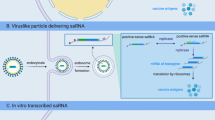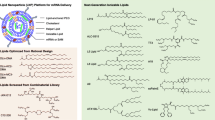Abstract
A vaccine that induces broadly neutralizing antibodies (bnAbs) against the human immunodeficiency virus (HIV) would be instrumental in controlling the disease. The membrane proximal external region (MPER) peptide is an appealing antigen candidate since it is conserved and is the target of several human bnAbs, such as 2F5. We previously found that liposomes containing cobalt porphyrin-phospholipid (CoPoP) can bind to a his-tagged MPER peptide, resulting in biomimetic antigen presentation on a lipid bilayer. The present study generated various his-tagged, synthetic MPER fragments, which were bound to liposomes containing CoPoP and a synthetic monophosphoryl lipid A (MPLA) and assessed for immunogenicity in mice. MPER peptides with amino acids stretches originating from the membrane insertion point that were at least 25 amino acids in length, had greater 2F5 reactivity and induced stronger antibody responses, compared to shorter ones. Immunization with the lipid-presented MPER elicited stronger antibody responses compared to Alum and Montanide adjuvants, which could recognize recombinant gp41 and gp140 proteins that contained MPER sequences. The induced antibodies neutralized a tier 1A virus that is sensitive to neutralizing antibodies (W61D(TCLA)0.71), but not another tier 1A nor a tier 2 strain. Co-formulation of the MPER peptide with an unrelated malaria protein antigen (Pfs25) that is effectively adjuvanted with liposomes containing CoPoP and MPLA resulted in elicitation of higher MPER antibody levels, but did not improve neutralization, possibly due to interference with proper peptide presentation in the membrane. Murine hybridomas were generated that produced MPER antibodies, but they were non-neutralizing. These results do not show that bnAbs could be generated with MPER peptides and CoPoP liposomes, but do not rule out this possibility with additional improvements to the approach.







Similar content being viewed by others
References
Aikins, M. E., J. Bazzill, and J. J. Moon. Vaccine nanoparticles for protection against HIV infection. Nanomedicine 12:673–682, 2017.
Apellániz, B., and J. L. Nieva. The use of liposomes to shape epitope structure and modulate immunogenic responses of peptide vaccines against HIV MPER. Advances in Protein Chemistry and Structural Biology, Elsevier: New York, 2015, pp. 15–54.
Banerjee, S., H. Shi, M. Banasik, H. Moon, W. Lees, Y. Qin, A. Harley, A. Shepherd, and M. W. Cho. Evaluation of a novel multi-immunogen vaccine strategy for targeting 4E10/10E8 neutralizing epitopes on HIV-1 gp41 membrane proximal external region. Virology 505:113–126, 2017.
Banerjee, S., H. Shi, H. H. Habte, Y. Qin, and M. W. Cho. Modulating immunogenic properties of HIV-1 gp41 membrane-proximal external region by destabilizing six-helix bundle structure. Virology 490:17–26, 2016.
Bomsel, M., D. Tudor, A. S. Drillet, A. Alfsen, Y. Ganor, M. G. Roger, N. Mouz, M. Amacker, A. Chalifour, L. Diomede, G. Devillier, Z. Cong, Q. Wei, H. Gao, C. Qin, G. B. Yang, R. Zurbriggen, L. Lopalco, and S. Fleury. Immunization with HIV-1 gp41 subunit virosomes induces mucosal antibodies protecting nonhuman primates against vaginal SHIV challenges. Immunity 34:269–280, 2011.
Burton, D. R., R. Ahmed, D. H. Barouch, S. T. Butera, S. Crotty, A. Godzik, D. E. Kaufmann, M. J. McElrath, M. C. Nussenzweig, B. Pulendran, C. N. Scanlan, W. R. Schief, G. Silvestri, H. Streeck, B. D. Walker, L. M. Walker, A. B. Ward, I. A. Wilson, and R. Wyatt. A blueprint for HIV vaccine discovery. Cell Host Microb. 12:396–407, 2012.
Carravilla, P., A. Cruz, I. Martin-Ugarte, I. R. Oar-Arteta, J. Torralba, B. Apellaniz, J. Pérez-Gil, J. Requejo-Isidro, N. Huarte, and J. L. Nieva. Effects of HIV-1 gp41-derived virucidal peptides on virus-like lipid membranes. Biophys. J. 113:1301–1310, 2017.
Carter, K. A., S. Shao, M. I. Hoopes, D. Luo, B. Ahsan, V. M. Grigoryants, W. Song, H. Huang, G. Zhang, R. K. Pandey, J. Geng, B. A. Pfeifer, C. P. Scholes, J. Ortega, M. Karttunen, and J. F. Lovell. Porphyrin–phospholipid liposomes permeabilized by near-infrared light. Nat. Commun. 5:3546, 2014.
Chakrabarti, B., L. Walker, J. Guenaga, A. Ghobbeh, P. Poignard, D. Burton, and R. Wyatt. Direct antibody access to the HIV-1 membrane-proximal external region positively correlates with neutralization sensitivity. J. Virol. 85:8217–8226, 2011.
Donius, L. R., Y. Cheng, J. Choi, Z.-Y. J. Sun, M. Hanson, M. Zhang, T. M. Gierahn, S. Marquez, M. Uduman, S. H. Kleinstein, D. Irvine, J. C. Love, E. L. Reinherz, and M. Kim. Generation of long-lived bone marrow plasma cells secreting antibodies specific for HIV-1 gp41 MPER in the absence of polyreactivity. J. Virol. 90:8875–8890, 2016.
Florese, R. H., K. K. Van Rompay, K. Aldrich, D. N. Forthal, G. Landucci, M. Mahalanabis, N. Haigwood, D. Venzon, V. S. Kalyanaraman, M. L. Marthas, and M. Robert-Guroff. Evaluation of passively transferred, nonneutralizing antibody-dependent cellular cytotoxicity-mediating IgG in protection of neonatal rhesus macaques against oral SIVmac251 challenge. J. Immunol. 177:4028–4036, 2006.
Hanson, M. C., W. Abraham, M. P. Crespo, S. H. Chen, H. Liu, G. L. Szeto, M. Kim, E. L. Reinherz, and D. J. Irvine. Liposomal vaccines incorporating molecular adjuvants and intrastructural T-cell help promote the immunogenicity of HIV membrane-proximal external region peptides. Vaccine 33:861–868, 2015.
Ho, J., R. A. Uger, M. B. Zwick, M. A. Luscher, B. H. Barber, and K. S. MacDonald. Conformational constraints imposed on a pan-neutralizing HIV-1 antibody epitope result in increased antigenicity but not neutralizing response. Vaccine 23:1559–1573, 2005.
Huang, W. C., B. Deng, C. Lin, K. A. Carter, J. Geng, A. Razi, X. He, U. Chitgupi, J. Federizon, B. Sun, C. A. Long, J. Ortega, S. Dutta, C. R. King, K. Miura, S. Lee, and J. F. Lovell. A malaria vaccine adjuvant based on recombinant antigen binding to liposomes. Nat. Nanotechnol. 13:1174–1181, 2018.
Kim, M., Z.-Y. J. Sun, K. D. Rand, X. Shi, L. Song, Y. Cheng, A. F. Fahmy, S. Majumdar, G. Ofek, Y. Yang, P. D. Kwong, J. Wang, J. R. Engen, G. Wagner, and E. L. Reinherz. Antibody mechanics on a membrane-bound HIV segment essential for GP41-targeted viral neutralization. Nat. Struct. Mol. Biol. 18:1235–1243, 2011.
Lovell, J. F., C. S. Jin, E. Huynh, H. Jin, C. Kim, J. L. Rubinstein, W. C. Chan, W. Cao, L. V. Wang, and G. Zheng. Porphysome nanovesicles generated by porphyrin bilayers for use as multimodal biophotonic contrast agents. Nat. Mater. 10:324, 2011.
Mascola, J. R., G. Stiegler, T. C. VanCott, H. Katinger, C. B. Carpenter, C. E. Hanson, H. Beary, D. Hayes, S. S. Frankel, D. L. Birx, and M. G. Lewis. Protection of macaques against vaginal transmission of a pathogenic HIV-1/SIV chimeric virus by passive infusion of neutralizing antibodies. Nat. Med. 6:207–210, 2000.
Matyas, G. R., L. Wieczorek, Z. Beck, C. Ochsenbauer-Jambor, J. C. Kappes, N. L. Michael, V. R. Polonis, and C. R. Alving. Neutralizing antibodies induced by liposomal HIV-1 glycoprotein 41 peptide simultaneously bind to both the 2F5 or 4E10 epitope and lipid epitopes. AIDS 23:2069–2077, 2009.
McCoy, L. E., and D. R. Burton. Identification and specificity of broadly neutralizing antibodies against HIV. Immunol. Rev. 275:11–20, 2017.
Montefiori, D. C. Measuring HIV neutralization in a luciferase reporter gene assay. HIV Protocols, Berlin: Springer, 2009, pp. 395–405.
Montero, M., N. Gulzar, K.-A. Klaric, J. E. Donald, C. Lepik, S. Wu, S. Tsai, J.-P. Julien, A. J. Hessell, S. Wang, S. Lu, D. R. Burton, E. F. Pai, W. F. DeGrado, and J. K. Scott. Neutralizing epitopes in the membrane-proximal external region of HIV-1 gp41 are influenced by the transmembrane domain and the plasma membrane. J. Virol. 86:2930–2941, 2012.
Ofek, G., F. J. Guenaga, W. R. Schief, J. Skinner, D. Baker, R. Wyatt, and P. D. Kwong. Elicitation of structure-specific antibodies by epitope scaffolds. Proc. Natl. Acad. Sci. USA 107:17880–17887, 2010.
Sarkar, A., S. Bale, A. J. Behrens, S. Kumar, S. K. Sharma, N. de Val, J. Pallesen, A. Irimia, D. C. Diwanji, R. L. Stanfield, A. B. Ward, M. Crispin, R. T. Wyatt, and I. A. Wilson. Structure of a cleavage-independent HIV Env recapitulates the glycoprotein architecture of the native cleaved trimer. Nat. Commun. 9:1956, 2018.
Shao, S., T. N. Do, A. Razi, U. Chitgupi, J. Geng, R. J. Alsop, B. G. Dzikovski, M. C. Rheinstädter, J. Ortega, M. Karttunen, J. A. Spernyak, and J. F. Lovell. Design of hydrated porphyrin-phospholipid bilayers with enhanced magnetic resonance contrast. Small 13:1602505, 2017.
Shao, S., J. Geng, H. A. Yi, S. Gogia, S. Neelamegham, A. Jacobs, and J. F. Lovell. Functionalization of cobalt porphyrin–phospholipid bilayers with his-tagged ligands and antigens. Nat. Chem. 7:438, 2015.
Shao, S., V. Rajendiran, and J. F. Lovell. Metalloporphyrin nanoparticles: coordinating diverse theranostic functions. Coord. Chem. Rev. 379:99–120, 2019.
Steichen, J. M., D. W. Kulp, T. Tokatlian, A. Escolano, P. Dosenovic, R. L. Stanfield, L. E. McCoy, G. Ozorowski, X. Hu, O. Kalyuzhniy, B. Briney, T. Schiffner, F. Garces, N. T. Freund, A. D. Gitlin, S. Menis, E. Georgeson, M. Kubitz, Y. Adachi, M. Jones, A. A. Mutafyan, D. S. Yun, C. T. Mayer, A. B. Ward, D. R. Burton, I. A. Wilson, D. J. Irvine, M. C. Nussenzweig, and W. R. Schief. HIV vaccine design to target germline precursors of glycan-dependent broadly neutralizing antibodies. Immunity 45:483–496, 2016.
Venditto, V. J., D. S. Watson, M. Motion, D. Montefiori, and F. C. Szoka. Rational design of membrane proximal external region lipopeptides containing chemical modifications for HIV-1 vaccination. Clin. Vaccine Immunol. 20:39–45, 2013.
Venditto, V. J., L. Wieczorek, S. Molnar, F. Teque, G. Landucci, D. S. Watson, D. Forthal, V. R. Polonis, J. A. Levy, and F. C. Szoka. Chemically modified peptides based on the membrane-proximal external region of the HIV-1 envelope induce high-titer, epitope-specific nonneutralizing antibodies in rabbits. Clin. Vaccine Immunol. 21:1086–1093, 2014.
Verkoczy, L., G. Kelsoe, and B. F. Haynes. HIV-1 envelope gp41 broadly neutralizing antibodies: hurdles for vaccine development. PLoS Pathog. 10:1371, 2014.
Watson, D. S., and F. C. Szoka, Jr. Role of lipid structure in the humoral immune response in mice to covalent lipid–peptides from the membrane proximal region of HIV-1 gp41. Vaccine 27:4672–4683, 2009.
Acknowledgments
This work was supported by the National Institutes of Health (R01AI125119, R21AI122964, DP5OD017898, HHSN272201800004C). We would like to thanks Earl Poptic at Cleveland Clinic for hybridoma work. We acknowledge PATH-MVI for providing Pfs25.
Conflict of interest
JF.L and W.H. hold interest in POP Biotechnologies. All other authors declare no conflict of interest.
Author information
Authors and Affiliations
Corresponding author
Additional information
Associate Editor Debra T. Auguste oversaw the review of this article.
Publisher's Note
Springer Nature remains neutral with regard to jurisdictional claims in published maps and institutional affiliations.
Electronic Supplementary Material
Below is the link to the electronic supplementary material.
Rights and permissions
About this article
Cite this article
Shao, S., Huang, WC., Lin, C. et al. An Engineered Biomimetic MPER Peptide Vaccine Induces Weakly HIV Neutralizing Antibodies in Mice. Ann Biomed Eng 48, 1991–2001 (2020). https://doi.org/10.1007/s10439-019-02398-8
Received:
Accepted:
Published:
Issue Date:
DOI: https://doi.org/10.1007/s10439-019-02398-8




